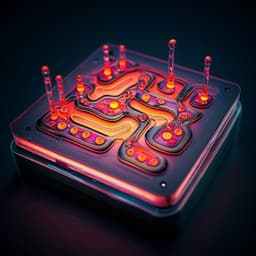
Earth Sciences
Half-life of the nuclear cosmochronometer $^{176}$Lu measured with a windowless 4π solid angle scintillation detector
T. Hayakawa, T. Shizuma, et al.
Discover groundbreaking research on the $^{176}$Lu-$^{176}$Hf nuclear decay, a critical tool for dating astrophysical and geological events. This study, led by Takehito Hayakawa, Toshiyuki Shizuma, and Tsuyoshi Iizuka, presents new half-life measurements that challenge existing values, utilizing an innovative windowless solid angle detector. Unlock the mysteries of time with this compelling research!
Playback language: English
Introduction
The $^{176}$Lu to $^{176}$Hf decay system serves as a crucial cosmochronometer, providing valuable insights into the ages of various astrophysical and geological phenomena. Its widespread application stems from the ability to determine the age of materials by analyzing the relative abundances of lutetium (Lu) and hafnium (Hf). Precise knowledge of the $^{176}$Lu half-life is paramount for accurate age determination using this method. However, a significant discrepancy exists in the literature regarding the half-life of $^{176}$Lu, with various experimental techniques yielding differing results. Furthermore, Lu-Hf isochron analyses of meteorites and terrestrial rocks with established ages reveal two distinct half-life values, highlighting the need for a more precise and reliable measurement. This study aims to address this inconsistency by employing a novel measurement technique that minimizes uncertainties inherent in previous methods, ultimately aiming to provide the most accurate $^{176}$Lu half-life to date. The significance of this endeavor lies in its potential to refine our understanding of early solar system evolution, planetary differentiation processes, and the timing of various geological events on Earth. An improved $^{176}$Lu half-life will allow for more accurate and precise dating of samples across diverse geological and cosmological contexts, contributing significantly to the fields of cosmochemistry, geochemistry, and astrophysics.
Literature Review
Numerous studies have attempted to determine the half-life of $^{176}$Lu using various techniques, including γ-ray counting, γ-γ coincidence, and liquid scintillation methods. These studies have yielded a range of half-life values, as illustrated in Figure 2 of the paper. Some studies utilized meteorite and terrestrial rock samples with known ages to infer the half-life through isochron dating methods. The inconsistencies between these different approaches, particularly the discrepancy between values obtained from meteorites versus terrestrial rocks, highlight the challenges associated with precise half-life determination. The existing literature reveals a significant spread in reported values, with some suggesting a shorter half-life and others indicating a longer one. These differences likely stem from systematic uncertainties in previous experimental techniques, including variations in sample preparation, detection efficiency, background radiation interference, and complex decay schemes that make accurate data interpretation difficult. Understanding and resolving these discrepancies is essential for improving the accuracy and reliability of $^{176}$Lu-based chronometry.
Methodology
This research employed a novel approach to determine the $^{176}$Lu half-life using a windowless 4π solid angle detector constructed from bismuth germanate (BGO) scintillation crystals. A natural lutetium sample was placed at the center of the detector, enabling near-complete detection of all decay products (photons and electrons). This setup offers significant advantages over previous methods. The near 100% detection efficiency minimizes uncertainties associated with the efficiency calibration, which is a major source of error in other techniques. A schematic diagram of the detector system is shown in Figure 3a. Figure 3b illustrates the calculated detection probabilities for both photons and electrons emitted from the Lu sample, revealing that the detection efficiency exceeds 99.5% for photons in the relevant energy range. To ensure accurate background subtraction, separate measurements of background radiation were conducted without the lutetium sample. The energy spectra from the $^{133}$Ba standard source used for calibration are displayed in Figure 4a and 4b, demonstrating the detector's ability to resolve distinct γ-ray peaks. Figure 4c shows the spectrum from the lutetium sample and the background spectrum. Background radiation sources included Pb x-rays and a 570 keV γ-ray from $^{207}$Bi present in the BGO crystals, as well as a 662 keV γ-ray from $^{137}$Cs contamination in the experimental room. After subtracting the background spectrum (Figure 4d), the characteristic peaks of $^{176}$Lu were clearly visible. The half-life was calculated using Equation (1), which accounts for factors such as measurement time, sample mass, Avogadro's number, detection efficiency, isotopic abundance, and the measured yield. Two independent measurements were performed on separate Lu samples (125.26 mg and 121.43 mg) to improve the accuracy and to assess reproducibility. Statistical and systematic uncertainties were rigorously considered to determine the overall uncertainty in the calculated half-life. The inductively coupled plasma mass spectrometry (ICP-MS) was used to measure the concentration of other possible radionuclides in the samples, ensuring that their contribution to the decay count was negligible. The PHITS particle and heavy ion transport code system was used for the calculation of the detection efficiency. The BrIcc calculation code was used to calculate the internal conversion coefficients and electron energies.
Key Findings
The study yielded a half-life value of (3.719 ± 0.007) × 10$^{10}$ yr for $^{176}$Lu, which corresponds to a decay constant of (1.864 ± 0.003) × 10$^{-11}$ yr⁻¹. This result is statistically consistent with the values obtained from terrestrial rock isochron analyses. The authors claim this measurement to be the most accurate to date, due to the unique advantages of their method. First, their method is insensitive to nuclear structure details such as γ-ray emission probability and the electron capture branching ratio. Second, the near-100% detection efficiency minimizes uncertainty related to detection efficiency calibration. Third, calibration sources were not needed for detection efficiency determination. Fourth, it bypasses the inconsistencies observed in analyses of meteorites. The obtained half-life values from the two Lu samples were (3.718 ± 0.005(stat.) ± 0.006(sys.)) × 10$^{10}$ yr and (3.720 ± 0.005(stat.) ± 0.006(sys.)) × 10$^{10}$ yr respectively. The total uncertainty was obtained from the uncertainty propagation in Equation (1). The high precision achieved through the use of the windowless 4π detector significantly improves upon previous methods and resolves discrepancies observed in previous studies. The consistency of the result with the values obtained from terrestrial rock samples suggests that these samples reflect a true half-life rather than those obtained from meteorites. The authors considered the possibility of decay acceleration in meteorites due to neutrons generated from cosmic rays, proposing a scenario where neutron-induced reactions could lead to an apparent shorter half-life value in certain meteorites.
Discussion
The findings of this study provide a highly precise and accurate half-life value for $^{176}$Lu, resolving inconsistencies present in previous measurements. The consistency of the measured half-life with those obtained from the analysis of terrestrial rocks using the isochron method suggests that the new value represents the true half-life of $^{176}$Lu. The shorter half-life values previously reported from meteorite analyses might be attributable to decay acceleration caused by neutron irradiation from cosmic rays. The authors propose a mechanism involving neutron capture and inelastic scattering that could lead to the production of $^{176}$Hf, thus potentially explaining the observed discrepancies without requiring a deficient of $^{176}$Lu. This new half-life value will lead to significant improvements in the accuracy of age determinations for geological and astrophysical samples using the Lu-Hf system. It enhances the reliability of the Lu-Hf chronometer as a powerful tool for studying the evolution of planetary bodies and various geological processes. The advancement in precision will benefit various fields, particularly cosmochemistry, geochemistry, and astrophysics.
Conclusion
This research presents a highly precise measurement of the $^{176}$Lu half-life using a novel windowless 4π solid angle scintillation detector. The obtained value of (3.719 ± 0.007) × 10$^{10}$ yr is consistent with the values obtained from terrestrial rocks. The superior precision of this method resolves previous discrepancies in the literature. This improved half-life will significantly enhance the accuracy and reliability of the Lu-Hf dating system, thereby contributing to a more precise understanding of the early solar system, planetary differentiation, and geological processes on Earth. Future work could focus on investigating the mechanisms of decay acceleration in meteorites, potentially using the new half-life value as a benchmark. Detailed studies of neutron-induced reactions in $^{176}$Lu and their impact on the Lu-Hf system in meteorites would further strengthen the interpretation of the results.
Limitations
While this study significantly improves the accuracy of the $^{176}$Lu half-life, some limitations need to be acknowledged. The analysis relies on the assumption that the lutetium sample is homogeneous with respect to isotopic abundance. While the authors conducted ICP-MS analysis, heterogeneities on a smaller scale might still exist, potentially affecting the results. The proposed mechanism for decay acceleration in meteorites due to neutron irradiation requires further experimental validation through detailed studies of neutron cross-sections and effects on the Lu-Hf system. The interpretation of decay acceleration relies on the current understanding of the decay scheme and related nuclear processes, and further refinement of these models could further refine the interpretation.
Related Publications
Explore these studies to deepen your understanding of the subject.







